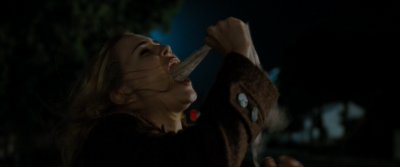
Only in a Sam Raimi movie will you see a character struggle with a possessed scarf hell bent determined to jam itself down said character's throat.
Review by Jay Wilson Sam Raimi’s Drag Me to Hell presents one of the most intriguing paradoxes I’ve faced in my movie watching career. On one hand, I do not like this movie. I did not enjoy watching it. In fact, I stopped it midway through and contemplated sending it back to Netflix because I just could not get into it. On the other hand, when I break the movie down into its individual elements I have nothing but affection and praise. I quickly brought up iTunes and purchased the score, and while listening to my new music acquisition I hunted through the movie to capture screens for this review, navigating with frightening precision to each scene because the visuals had burned so vividly in my memory, and after capturing the desired screen I’d often let the rest of the sequence play just to watch how the images flowed together in the editing. The story (re)tells the staple horror cliché of an individual haunted by an evil spirit. Alison Lohman plays a sweet innocent loan officer named Christine Brown who, just once, lets the prospect of personal gain get in the way of her warm hearted generosity. She denies an old (disgusting) gypsy woman with false teeth and freaky fingernails a third extension to her home loan because she wants a promotion and her boss informs her the bank would make a fortune in fees if the house was repossessed (and also mentioned that the new General Manager should be able to make the “tough decisions.”) The angered gypsy sets in motion the curse which drives the rest of the movie. 
Christine, her ambition for promotion, and her dread that her rival might get the job—all conveyed in a single shot. You gotta love that composition.

Sex is curiously absent from this horror/comedy even though Christine has a boyfriend. I find it surprisingly refreshing and appealing (if blatantly unrealistic) in a children’s fairy tale way.
And this brings me to my complaints. I’ve seen this movie before. I know invisible phantoms (this time called a “Lamia”) will stalk Christine in her house when she’s alone. I know she’ll see things other characters can’t see, and this will lead to an embarrassing public outburst where everyone thinks she’s losing her mind. I know Christine will seek out a benign fortune teller, and find herself participating in a séance to summon and appease and/or confront the malicious Lamia. To his credit, Sam Raimi does make an effort to inject a sense of freshness with a comedic edge and creative twists to the tired old clichés. For example, in many films with an unseen stalking spirit, protagonists would at best push against an invisible barrier, but most times their whole bodies would levitate, fly through the air, or they’d start convulsing uncontrollably. The evil spirit in Drag Me to Hell prefers to slug the mere mortals in the face with an invisible fist (which often sends them flying.) This didn’t sit well with me at first, but after awhile it did start to grow on me. There’s not enough evil brawler spirits in movies. A more bizarre example, Christine, driven to desperation, goes through everything on her property looking for anything she can pawn to afford the aforementioned séance. This journey brings her to a dark shadowy shed which, in a horror movie, is a ripe place for a jump scare. Indeed, Christine turns around and sees the old Gypsy who slams her against a support beam, pulls her fist back, and punches Christine in the mouth. And the Gypsy’s arm literally goes into Christine’s mouth all the way up to the elbow. No blood or gore, just a very surreal image. And as if that isn’t enough, Christine (with a mouthful of Gypsy arm) looks up and notices—I kid you not—an anvil hanging over the old gypsy’s head. This horror/comedy mix is a throwback, of course, to Evil Dead II (also directed by Sam Raimi). And while Evil Dead II remains one of my all time favorite movies, the magic just isn’t there for Drag Me to Hell. I watched these scenes play out with masterful execution, but instead of laughing or smiling I just rolled my eyes. And, I hate to say it, but I almost think I would have liked Drag Me to Hell a lot more if it played more of its moments straight or even (God I hate to say this) more conventionally. I don’t know. I really don’t. I’m at a loss with this movie. 
Dileep Rao is charismatic as all hell playing Rham Jas, the typical contemporary fortune teller versed in Freud and Jung.
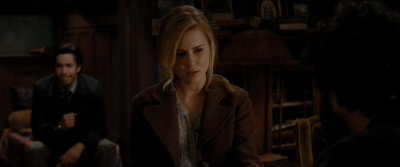
I love this shot. Three characters in frame; three levels of belief. Rham Jas closest with his absolute faith; Clay, the skeptic, farthest away; and an uncertain Christine right in the middle.
And to make matters worse, the film’s premise all but guarantees the stock scene that I absolutely despise. The one where Character A (Christine, in this case) attends a social gathering and is aware of something no other character is receptive to (in this case, the Lamia spirit screwing with her mind.) Every single genre calls upon this scene, but horror and comedy draw from this well every chance it can cram one in. And I’m hard-pressed to think of many instances where it A. did not reek of artificiality B. served any purpose beyond getting all the actors to make funny faces. If you’re going to shatter the walls of believability, fine. But, for God’s sake, do it over something interesting to watch. Blow something up. Stab something. I don’t care. There’s better reasons to have actors raise their eyebrows. So, I watched this dinner scene with no investment while Christine tries to ignore the loud noises she hears, the blood and eyeballs she sees in her cake, until the inevitable breakdown when she throws her glass and screams atop her lungs and everyone else stares at her. And like every other instance, while the weirdness escalates I think to myself, “You know, I’ve used the ‘I have a headache; I need to go lay down’ excuse for much, much, much less than that.” Why doesn’t anyone ever make up BS excuses and excuse themselves? And, again, Raimi does what he can to inject freshness into this overused scene. Most directors are content to leave the weirdness at the eyeball and blood oozing from the cake, but Raimi goes the step further and has the cake swallow up Christine’s fork. And there is something charming about how Christine looks down, then at the other people at the table, and actually laughs. A subtle crazy “someone just shoot me now” laugh. And when Christine sees and hears the Lamia on the verge of breaking the door down, as Raimi rapidly cuts to crazy tilted angles and ever moving cameras, I dare you to find a more energized sequence in your average summer blockbuster. 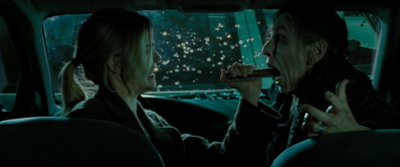
A freaky crazy person stabbed in the mouth with a ruler. Gruesome, yet goofy. Yep, this is vintage Sam Raimi.

In the long history of awkward “character sees something no one else can see” social scene, I don't think have ever seen one that didin't scream artificiality.
And there’s the dilemma. Drag Me to Hell does what it does well. Damn well. It knows it’s poking fun at crappy movie conventions; it indulges in clichés to take aim at them and mock them (and show the kiddies how it’s done.) The film clearly establishes its intentions, and does a hell of a job pursuing its agenda. But I’ll be damned if I can put my finger on why I didn’t go along for the ride. Sam Raimi is one of those directors with a very distinctive style. At his best, whether working on big-budget spectaculars like Spider Man 2 or tiny cult films like Evil Dead II, his movies give off a high-octane kinetic vibe. Even his worst movies are wall-to-wall energy, that breeze by regardless of the running time. You can complain about too many villains, too much going on, and downright stupid decision in, say, Spider Man 3, but one thing even a bad Raimi movies does not have is dead weights and dull moments. In Drag Me to Hell, Sam Raimi and Peter Deming provide great interesting images which are fun, even mesmerizing, to look at. Bob Murawski’s dynamic editing matches the energy that Deming’s camera infuses in the frame. Between Raimi’s directing, Deming’s photography, and Murawski’s editing, Drag Me to Hell has an absolutely flawless rhythm. Action sequences breeze by with remarkable clarity that Michael Bay’s Transformers series can only dream about. When Christine stabs the Gypsy in the mouth with the nearest weapon (a ruler), it goes to a medium shot and lingers just long enough for the horror and comedy to sink in, and then the fight resumes with an adrenal vengeance. They say good editing is editing that you don’t notice (because you don’t want it to draw attention to itself and get in the way of the story.) Towards the end of the film in the cemetery, after Christine has given the curse to a soul who already passed on, she turns to climb out of the open grave and we see the same turn three times at different distances ... and somehow (I’ll be damned if I can say how) this stylish decision felt so natural, so organic, I didn’t even notice it until trying to grab a frame. 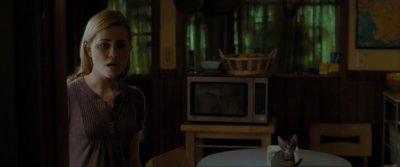
Mr. Raimi, on behalf of all horror fans, I would like to thank you for not using a “and a cat jumps out” shock moment despite having a (cute) kitten prominently established in the story.

No one does over-the-top spectacle better than Sam Raimi.
And the music—how I adore the music—Christopher Young is a composer I’ve long admired. Over the opening credits we here a violin concerto that sounds like it’s spinning an intricate melodic web; Christine receives a simple but heart-melting piano theme that breathes the very essence of innocence and sweetness, and evolves to soul-wrenching sadness later on in the film as the Lamia closes in on Christine’s soul. And, Young, no stranger to horror scores, unsettles those creepy scenes of empty garages, dark houses, with typical long dissonant notes from the Strings section of the orchestra, and I particularly liked the gypsy undertones and creative use of ambient sounds. Horror scores rarely provide “casual listening” music as they’re designed to put people on edge, but the better ones are often fascinating to listen to from a technical point of view (in a music theory sense). Drag Me to Hell contains the best of both worlds. Lastly, the actors, their characters, and their chemistry. Central to a movie of this nature is the sympathies for the protagonist, and Christine Brown is one of the most sympathetic character I’ve seen on film. We meet her as she drives to work, listening to a CD to help her diction which implies a hint of self-doubts but at the same time conveys a willingness to better herself. She brings her boyfriend a rare coin to add to his “nerdy coin collection,” and we see she’s thoughtful. She fixes his printer, demonstrating her competence. Christine makes mistakes that hurt people, but through Alison Lohman’s performance (and those adorable brown eyes of hers) we see the emotional conflict and confusion that got her there, and after she realizes the full impact of her errors we see the sorrow and regret. And, thus, those mistakes only serve to make her more sympathetic. They make her human. 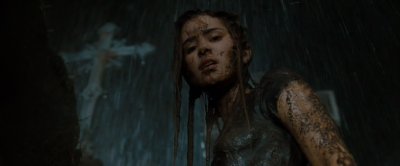
Composition is more than just making an image look pretty. It's also about communication and economy. Just look at how much information is conveyed by this one frame.
Justin Long plays Clay, and gets the difficult task of conveying intimacy without an explicitly intimate scene. But this gives way to my favorite moment in Drag Me to Hell where, Christine, desperately tries to raise $10,000 by pawning everything she can think of and sits defeated having only earned a little over $3,000. Clay enters the house and sits beside her, unfazed by the money neatly stacked on the table. He doesn’t ask a single question, and simply tells her he paid the money to the fortune teller whom he thinks is a fraud. She asks why, and he tells her, “because you believe, and that’s good enough for me.” Lorna Raver’s performance as the evil gypsy is wickedly funny and ominous at the same time, struggling comically with false teeth one moment, and convincingly bestowing a curse the next. I enjoyed watching Rham Jas, the fortune teller (Dileep Rao), have a polite intellectual spar with Clay, a Professor of Psychology and skeptic. And David Paymer and Reggie Lee delightfully play Christine’s boss and rival for the GM job—two characters the audience is destined to hate (but in a good way.) Like I said from the beginning, I have nothing but adoration and praise for the individual elements of Drag Me to Hell. And, somehow, despite my love for look, the sound, the rhythm, and the cast ... somehow that love does not translate to the movie as a whole. | ||||||||||||||||||||
|
| ||||||||||||||||||||
